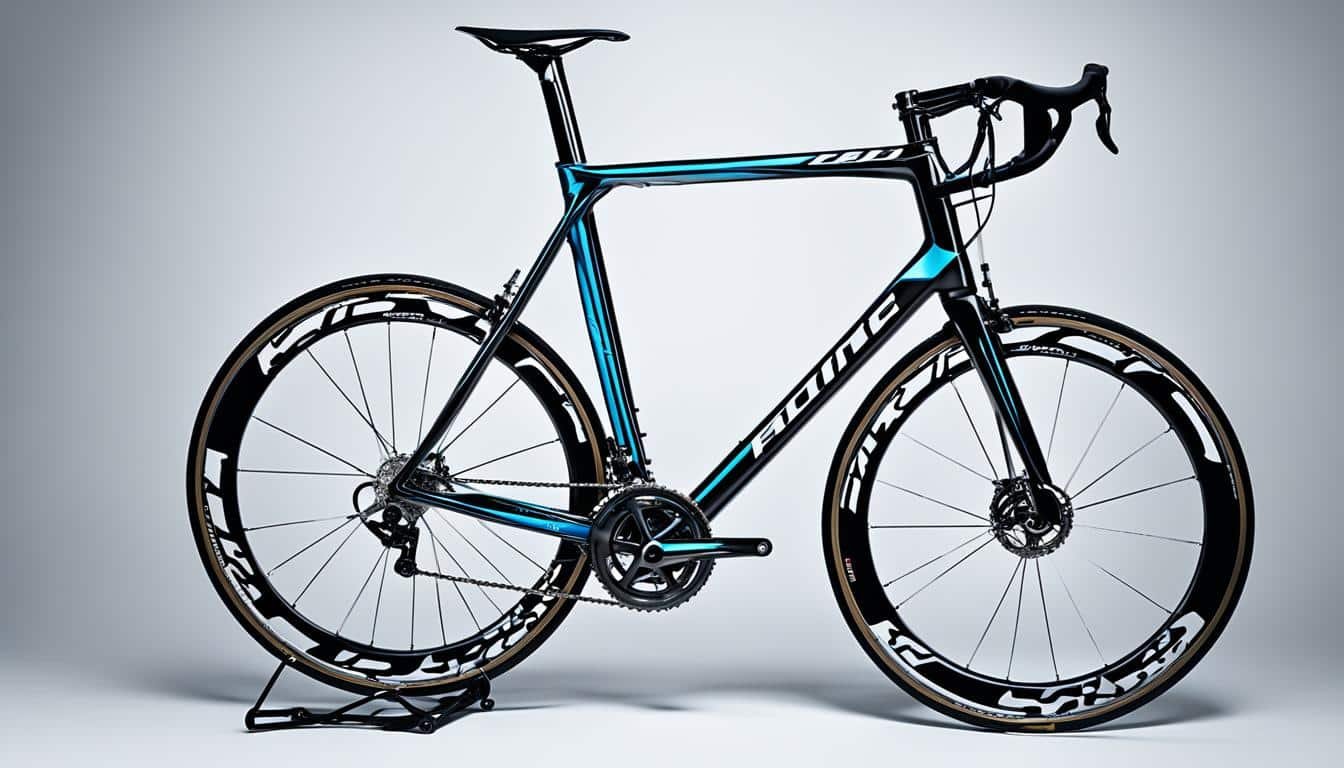When it comes to bicycles, understanding the basic parts is crucial for both beginners and experienced riders. From the frame to the brakes, pedals, gears, and saddle, each component plays a vital role in the overall performance and functionality of a bike.
The frame serves as the backbone of the bicycle, providing structural support and stability. It holds all the other components together and determines the bike’s size, shape, and weight.
The brakes are essential for safety, allowing the rider to slow down or come to a stop. There are different types of brakes, including rim brakes and disc brakes, each with its own advantages and characteristics.
The pedals are what transfer power from the rider’s legs to the drivetrain, propelling the bike forward. They come in various designs and materials to suit different types of riding and personal preferences.
The gears are responsible for controlling speed and shifting between different levels of resistance. They allow riders to adapt to varying terrains and maintain an efficient cadence.
The saddle, also known as the bike seat, provides a comfortable and ergonomic place for the rider to sit. It comes in different shapes, sizes, and materials to accommodate individual preferences and riding styles.
Key Takeaways:
- The basic parts of a bike include the frame, brakes, pedals, gears, and saddle.
- The frame is the foundation of the bike, providing structure and support.
- Brakes are crucial for safety, allowing the rider to slow down or stop.
- Pedals transfer power from the rider’s legs to propel the bike forward.
- Gears help control speed and adapt to different terrains.
- The saddle provides a comfortable seat for the rider.
Bike Frame Parts
The bike frame is the foundation of the bike and plays a critical role in its overall performance. It is typically made of materials such as steel, aluminum alloy, carbon fiber, or titanium, chosen for their strength, weight, and durability. Let’s explore the key components of a bike frame:
Top Tube
The top tube is a horizontal bar that extends from the bike’s head tube to the seat tube. It provides structural rigidity and stability to the frame. Additionally, it serves as the bar that the rider steps over when mounting and dismounting the bike.
Head Tube
The head tube is located at the front of the bike frame and connects the handlebars to the wheel fork. It houses the bearings and headset components that allow for smooth steering and control.
Down Tube
The down tube is a vertical tube that runs from the head tube to the pedals. It contributes to the overall stiffness and strength of the frame and helps to distribute the rider’s weight and pedaling forces evenly.
Seat Tube
The seat tube is located at the rear of the bike frame and connects the saddle to the pedals. It determines the rider’s riding position and can often be adjusted for optimal comfort and performance.
Seat Stays
The seat stays are two tubes that extend from the seat tube to the rear wheel hub. They provide additional support and stability to the rear end of the bike frame.
Chain Stays
The chain stays are two tubes that run parallel to the bike chain from the bottom bracket to the rear wheel hub. They help to maintain the proper chain tension and contribute to the overall stiffness and efficiency of the bike frame.
Understanding the various parts of a bike frame is essential for cyclists as it enables them to make informed decisions about frame materials, geometry, and overall bike performance. By familiarizing yourself with these components, you can better appreciate the design and engineering that goes into creating a high-quality bike frame.
Front of the Bike Parts
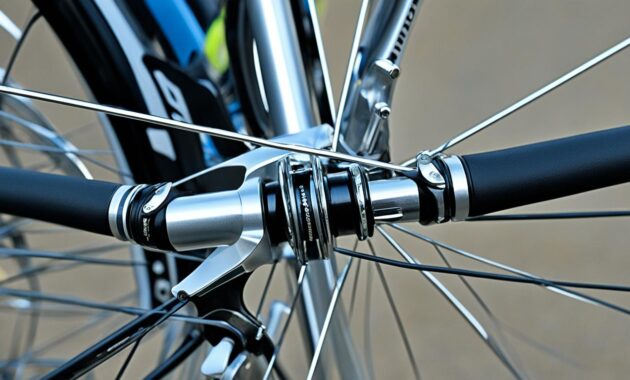
When it comes to the front of the bike, there are several key components that play a crucial role in steering and control. Let’s take a closer look at each of these parts:
Fork
The fork is an essential part that connects the front wheel to the bike’s frame. It provides stability and allows for smooth steering. The fork absorbs shocks and vibrations from the road, ensuring a comfortable ride for the cyclist.
Headset
The headset is a set of components that connect the frame and the wheel fork. It allows for smooth rotation of the fork and provides stability when turning the handlebars. A well-functioning headset ensures precise steering control.
Stem
The stem attaches the fork to the handlebars. It determines the height and reach of the handlebars, allowing the rider to find a comfortable riding position. The stem also plays a role in bike handling and stability.
Handlebars
The handlebars are the primary control point for the cyclist. They provide a grip for steering and control, allowing the rider to navigate through different terrains. Handlebars come in various shapes and styles, each offering a unique riding experience.
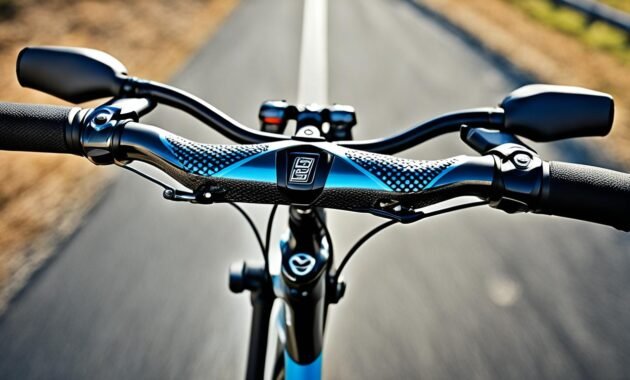
Brake Levers
Brake levers are the parts that the rider squeezes to slow down or stop the bike. They are usually located on the handlebars, within easy reach of the cyclist’s hands. When the brake levers are engaged, they activate the brakes, providing the necessary stopping power for a safe ride.
These front bike parts work together to ensure proper steering, control, and braking. Understanding their functions and importance can help cyclists make informed decisions when it comes to bike maintenance and upgrades.
Bike Wheel Parts
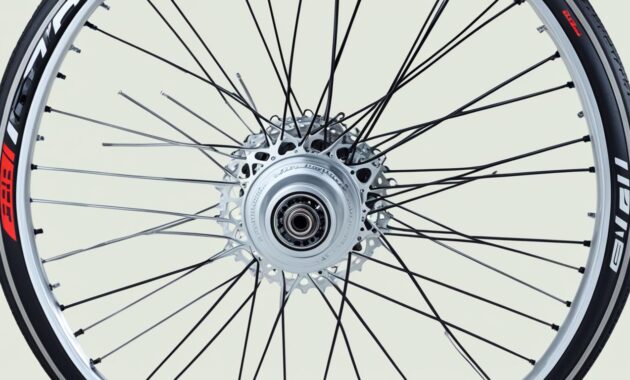
The bike wheel is a complex assembly of various components, each playing a crucial role in its overall performance. Let’s dive into the different parts that make up a bike wheel.
Hub
The hub is the central component of the bike wheel, located at its core. It contains a set of bearings that allow the wheel to rotate smoothly. Without a properly functioning hub, the wheel would not be able to spin freely. The hub is connected to the bike frame via the axle.
Rim
The rim is the outer circle of the bike wheel, providing the structure and support necessary for the tire. It is usually made of lightweight and durable materials such as aluminum alloy or carbon fiber. The rim plays a vital role in maintaining the shape and integrity of the wheel.
Spokes
Spokes are metal rods that connect the rim to the hub. They radiate out from the hub in a spiderweb-like pattern and provide stability and strength to the wheel. The tension in the spokes helps distribute the weight and forces applied to the wheel during riding, ensuring a balanced and reliable ride.
Tire
The tire is the outermost part of the bike wheel and is critical for providing traction, cushioning, and protection against impact. It is typically made of rubber and comes in various tread patterns and sizes to suit different riding conditions. The tire is responsible for gripping the road surface and absorbing shocks for a comfortable and safe ride.
Now that we’ve explored the key components of a bike wheel, it’s evident that each part has a specific function that contributes to the overall performance and durability of the wheel.
| Component | Function |
|---|---|
| Hub | Enables the wheel to rotate smoothly |
| Rim | Provides structure and support to the wheel |
| Spokes | Connect the rim to the hub and provide stability |
| Tire | Provides traction, cushioning, and protection |
Having a good understanding of these bike wheel parts is essential for any cyclist. It allows you to better appreciate the intricacies of your bike and make informed decisions when it comes to maintenance, repairs, and upgrades.
Back of the Bike Parts
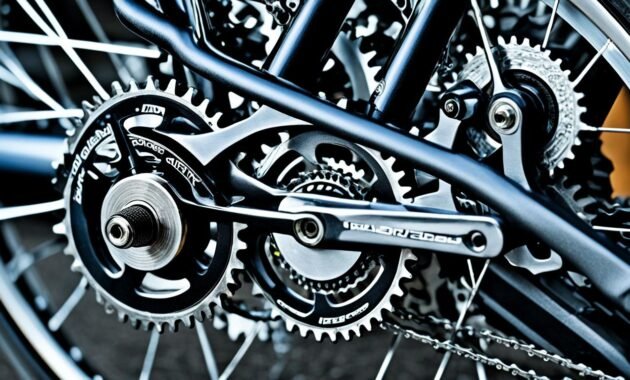
When it comes to the back of the bike, there are several important components to consider, including the crankset, pedals, bottom bracket, and chain. Each of these parts plays a crucial role in powering the bike and ensuring a smooth and efficient ride.
Crankset
The crankset, consisting of cranks and chainrings, is located at the center of the bike and is responsible for transferring the rider’s pedaling power to the rear wheel. As the rider pushes down on the pedals, the cranks rotate, turning the chainrings and ultimately propelling the bike forward.
Pedals
The pedals serve as the interface between the rider’s feet and the crank arms. They provide a secure platform for the rider to apply force to the cranks, allowing them to turn with each pedal stroke. Pedals come in a variety of designs, including platform pedals for casual riding and clipless pedals that attach to special cycling shoes for increased efficiency and control.
Bottom Bracket
The bottom bracket is the component that connects the crankset to the frame of the bike. It houses the bearings that allow the cranks to rotate smoothly while supporting the weight and force exerted by the rider. Bottom brackets come in different types, such as cartridge bottom brackets and external bottom brackets, each offering their own set of benefits in terms of durability and performance.
Chain
The chain plays a crucial role in transferring power from the crankset to the rear wheel. As the cranks rotate, the chain moves along the chainrings and cassette, engaging with the teeth of each component. This motion transfers rotational force from the crankset to the rear wheel, propelling the bike forward. It is important to keep the chain properly lubricated and maintained to ensure smooth and efficient power transfer.
| Component | Description |
|---|---|
| Crankset | Consists of cranks and chainrings, transfers pedaling power to the rear wheel |
| Pedals | Interface between the rider’s feet and the crank arms |
| Bottom Bracket | Connects the crankset to the frame and houses the bearings for smooth rotation |
| Chain | Transfers power from the crankset to the rear wheel |
Understanding the back of the bike and how these components work together is essential for maintaining and maximizing the performance of your bicycle. Whether you’re a casual rider or a dedicated cyclist, taking care of these parts ensures a smooth and enjoyable ride on any terrain.
Bike Seat Parts
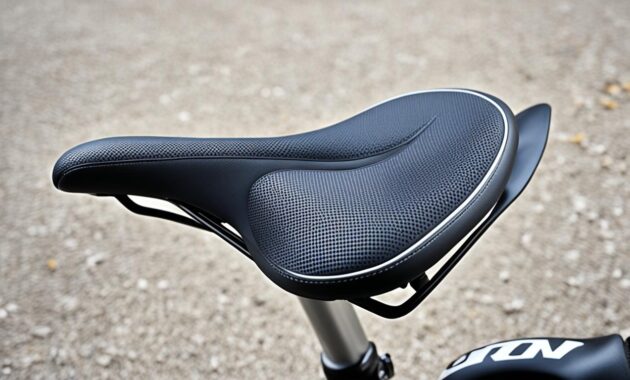
When it comes to bike comfort, the saddle and seat post play a crucial role. The saddle, also known as the bike seat, is where the rider sits and provides the necessary support and comfort during rides.
The saddle is usually padded and designed ergonomically to reduce pressure on sensitive areas. It is attached to the seat post, which is inserted into the frame of the bike. The seat post allows for height adjustment, ensuring the rider’s legs are properly extended while pedaling, which enhances comfort and efficiency.
The Importance of a Properly Adjusted Saddle
Having the saddle at the correct height and angle is crucial for optimal riding comfort and performance. A saddle set too low can put excess strain on the knees and hamstrings, leading to discomfort and potential injury. On the other hand, a saddle set too high can cause the rider to rock side to side, leading to inefficient pedaling.
To adjust the saddle height, the seat post can be loosened and raised or lowered based on the rider’s preference. It is recommended to start with a neutral position and make small adjustments until the perfect saddle height is achieved.
Choosing the Right Saddle
Choosing the right saddle depends on personal preference and riding style. There are various types of saddles available, including those designed for road biking, mountain biking, and leisure riding. Factors to consider when selecting a saddle include cushioning, width, shape, and cutouts.
| Saddle Type | Features |
|---|---|
| Road Bike Saddle | Narrow width, lightweight, minimal padding |
| Mountain Bike Saddle | Wider width, more padding, durable materials |
| Leisure Bike Saddle | Wide and cushioned for comfort during casual rides |
It is recommended to try different saddles and seek professional help if necessary to ensure the perfect fit and comfort.
Remember, a comfortable saddle can make all the difference in enjoying your bike rides and preventing discomfort or pain.
Brake Types
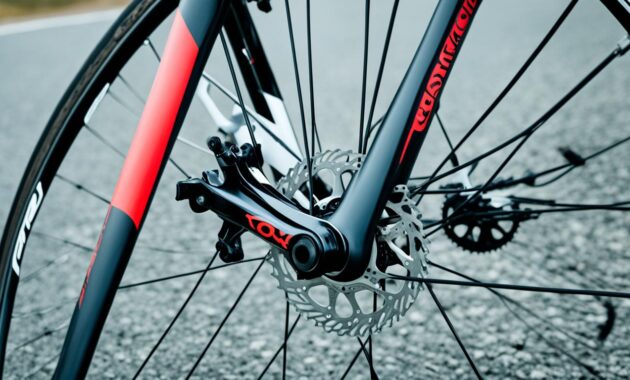
When it comes to bike brakes, there are two main types: rim brakes and disc brakes. Each type has its own unique advantages and considerations. Let’s take a closer look at each one.
Rim Brakes
Rim brakes are the most common type of brakes found on bikes. They work by applying pressure to the wheel rim, causing friction that slows down or stops the bike. Rim brakes are typically found on road bikes and are known for their simplicity and affordability.
One of the key benefits of rim brakes is that they are lightweight, which can be advantageous for cyclists looking to reduce the overall weight of their bike. Additionally, rim brakes are relatively easy to maintain and repair, with replacement brake pads being readily available.
“Rim brakes offer a reliable and cost-effective braking solution for most cyclists. They are lightweight, easy to maintain, and provide consistent stopping power.”
Disc Brakes
Disc brakes, on the other hand, use a disc rotor attached to the wheel hub to provide stopping power. When the brake lever is squeezed, the brake pads are pressed against the disc rotor, creating friction and slowing down the bike. Disc brakes are commonly found on mountain bikes and are gaining popularity in other disciplines as well.
One of the main advantages of disc brakes is their superior stopping power, especially in wet or muddy conditions where rim brakes may be less effective. Disc brakes also provide more consistent and predictable braking performance, as they are not affected by the wheel rim’s condition, such as dirt, debris, or damage.
However, it’s worth noting that disc brakes can be slightly heavier than rim brakes, which may be a consideration for performance-oriented cyclists. Additionally, maintenance and repairs for disc brakes can be slightly more complex and may require specific tools.
“Disc brakes offer excellent stopping power and consistent performance, making them a popular choice for off-road and all-weather riding.”
Choosing the Right Brakes
When it comes to selecting the right brakes for your bike, it’s important to consider your riding style, terrain, and personal preferences. Rim brakes can be a suitable choice for road cyclists or those looking for a lightweight and cost-effective braking solution. On the other hand, disc brakes can provide unparalleled stopping power and consistency, making them ideal for off-road or all-weather riding.
Ultimately, the decision between rim brakes and disc brakes is a matter of personal preference and specific riding needs. Both types of brakes offer reliable stopping power and can enhance your biking experience.
Types of Bicycle Gears
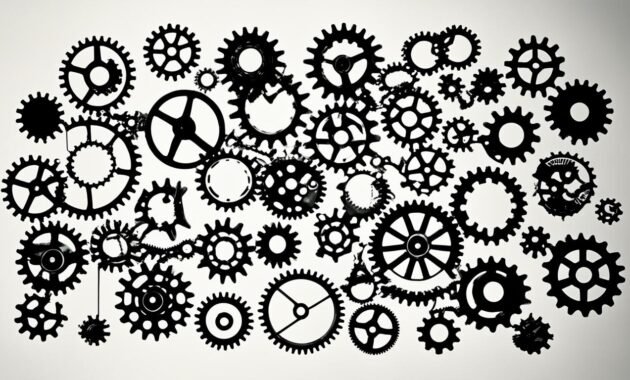
Bikes are equipped with different types of gears to enhance speed and control. These gears are controlled by a front derailleur and a rear derailleur, allowing riders to shift between various gear ratios. Let’s explore how these components work together to optimize performance.
The Front Derailleur:
The front derailleur is responsible for moving the chain between the chainrings on the crankset. When the rider shifts gears using the front derailleur, the chain is guided to a different-sized chainring, altering the gear ratio. This enables riders to manage their pedaling effort based on the terrain or desired speed.
The Rear Derailleur:
On the other hand, the rear derailleur controls the movement of the chain between the cogs on the cassette, which is attached to the rear wheel hub. By shifting gears with the rear derailleur, riders can achieve a finer adjustment of the gear ratio, allowing for more precision in speed control and ease of pedaling.
Overall, the combination of the front and rear derailleurs provides a wide range of gear choices, making it easier for cyclists to adapt to different terrains and cycling conditions. Whether facing steep climbs or fast descents, having multiple gears can significantly enhance the riding experience.
Benefits of Bicycle Gears
The incorporation of gears in bicycles offers several advantages:
- Improved Performance: Gears allow riders to maintain a comfortable cadence by adjusting the resistance to their pedaling effort. This helps conserve energy and prevent muscle fatigue, especially during long rides.
- Efficient Climbing: When faced with uphill terrain, riders can shift to lower gears, making it easier to pedal against the resistance of gravity.
- Enhanced Speed: On the other hand, higher gears enable riders to achieve higher speeds with less effort, ideal for riding on flat or downhill sections.
- Adaptability: The ability to change gears quickly and effortlessly allows cyclists to adapt to changing road conditions, headwinds, and varying levels of fitness.
Gears are essential components of modern bicycles, providing riders with versatility and flexibility in their cycling experience. By mastering gear shifting techniques and understanding their benefits, cyclists can optimize their rides and conquer diverse terrains with ease.
| Gear Component | Description |
|---|---|
| Front Derailleur | Moves the chain between chainrings on the crankset to adjust the gear ratio. |
| Rear Derailleur | Moves the chain between cogs on the cassette to fine-tune the gear ratio. |
Types of Bike Brakes
In addition to rim brakes and disc brakes, another type of bike brake is the hub brake. Hub brakes are commonly found on internal gear hub systems and are located inside the hub of the wheel. They offer durability and all-weather performance.
Bike Wheel Anatomy
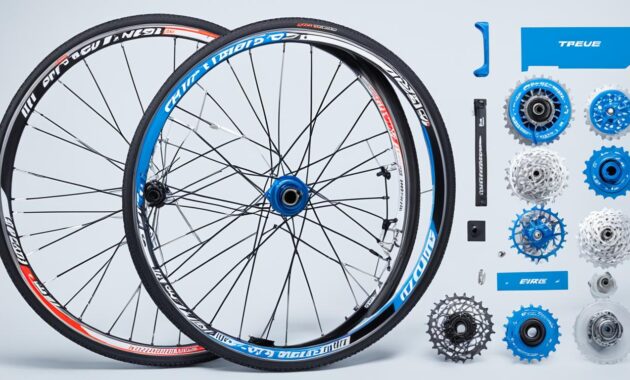
The bike wheel is a complex assembly of various components, each playing a crucial role in the smooth functioning of the bicycle. Let’s delve into the anatomy of a bike wheel to better understand its construction and functionality.
The Hub
The hub is the central part of the wheel, located at the very center and mounted onto the frame. It acts as the core, providing support and stability to the entire wheel assembly. The hub contains the bearings that allow the wheel to rotate freely.
The Rim
The rim is the outer circular part of the wheel that connects to the hub. It spans the diameter of the wheel and forms the structure to which the tire and spokes are attached. The rim provides stability and support to the tire, ensuring proper alignment and balance.
The Spokes
Spokes are the slender rods that connect the hub to the rim, forming a network of support. They are usually made of metal and radiate outwards from the hub, crossing each other in a pattern. Spokes distribute the rider’s weight and external forces evenly across the wheel, enhancing its strength and stability.
The Tire
The tire is the outermost part of the wheel, in direct contact with the road surface. It plays a vital role in providing traction and absorbing shocks, offering a smoother ride. The tire is typically made of rubber and can vary in tread pattern and width depending on the intended use of the bike.
The Tube
Inside the tire, there is a separate inner tube that holds the air necessary to inflate the tire. The tube is typically made of rubber and is inserted between the tire and the rim. It ensures proper pressure within the tire, allowing it to maintain its shape and provide optimal performance.
Together, the hub, rim, spokes, tire, and tube work harmoniously to create a functional and reliable bike wheel. The hub provides stability, the rim offers structural support, the spokes distribute forces, the tire provides traction, and the tube maintains tire pressure. Understanding the different components of a bike wheel can help cyclists appreciate the complexity and importance of this fundamental part of their bicycles.
Also Read : Mongoose Bike Your Guide To Rugged Adventure
Conclusion
Understanding the basic parts of a bike is essential for any cyclist. From the frame to the brakes, pedals, and gears, each component plays a crucial role in the overall function and performance of the bike.
By familiarizing yourself with these parts, you can better maintain and appreciate your bike for a smoother and more enjoyable ride.
Whether you’re a casual rider or a seasoned cyclist, knowing the anatomy of your bike and how its components work together is key to optimizing your riding experience. Take the time to inspect and maintain each part, ensuring they are properly adjusted and in good condition. This will not only enhance your bike’s performance but also contribute to your safety on the road or trails.
Remember, the bike components mentioned in this article are just the basics. Depending on your riding style and preferences, you may encounter additional parts and technologies, such as suspension systems or electronic shifting. Exploring these aspects can further enhance your understanding and enjoyment of the bike.
FAQs
Q: What are the basic parts of a road bike?
A: The basic parts of a road bike include the shifter, bicycle frame, and bicycle wheel.
Q: Can you explain what a shifter is on a bike?
A: A shifter is a component on a bike that allows the rider to change gears, controlling the bike’s speed and power.
Q: What is the function of the bicycle frame?
A: The bicycle frame is the main structure of the bike that holds all the components together and provides support for the rider.
Q: What are bicycle wheels composed of?
A: Bicycle wheels consist of a wheel axles, spokes, and rims, which help the bike move forward when in motion.
Q: How do brake calipers work on a bike?
A: Brake calipers are the components that squeeze the brake pads against the rim of the wheel, creating friction to slow down or stop the bike.
Q: What are the different parts of a bike frame?
A: The bike frame consists of the top of the head tube, rear gears of the bike, front of the frame, and top of the seat tube, among other components.
Q: What is the purpose of the jockey wheel on a bicycle?
A: The jockey wheel is a part of the bike’s rear derailleur system that guides the chain to facilitate smooth gear changes.
Q: How are the handlebars attached to the bike frame?
A: The handlebars are secured to the bike frame through the stem, which is a component that connects the handlebars to the steerer tube of the bike.
Source Links
- https://en.wikipedia.org/wiki/List_of_bicycle_parts
- https://thebestbikelock.com/parts-of-a-bike/
- https://www.steadcycles.com.au/the-most-basic-parts-of-a-bicycle-you-should-know/
